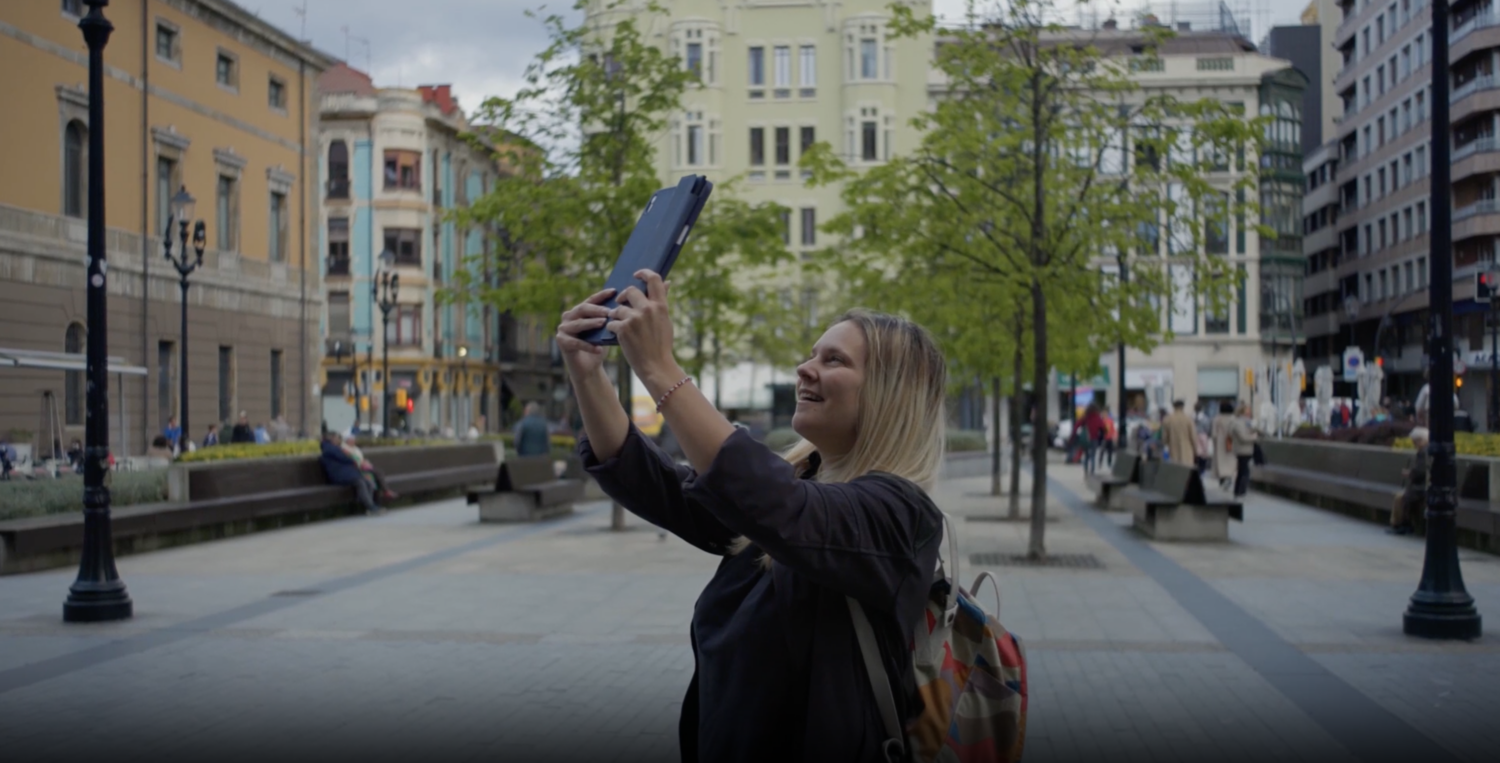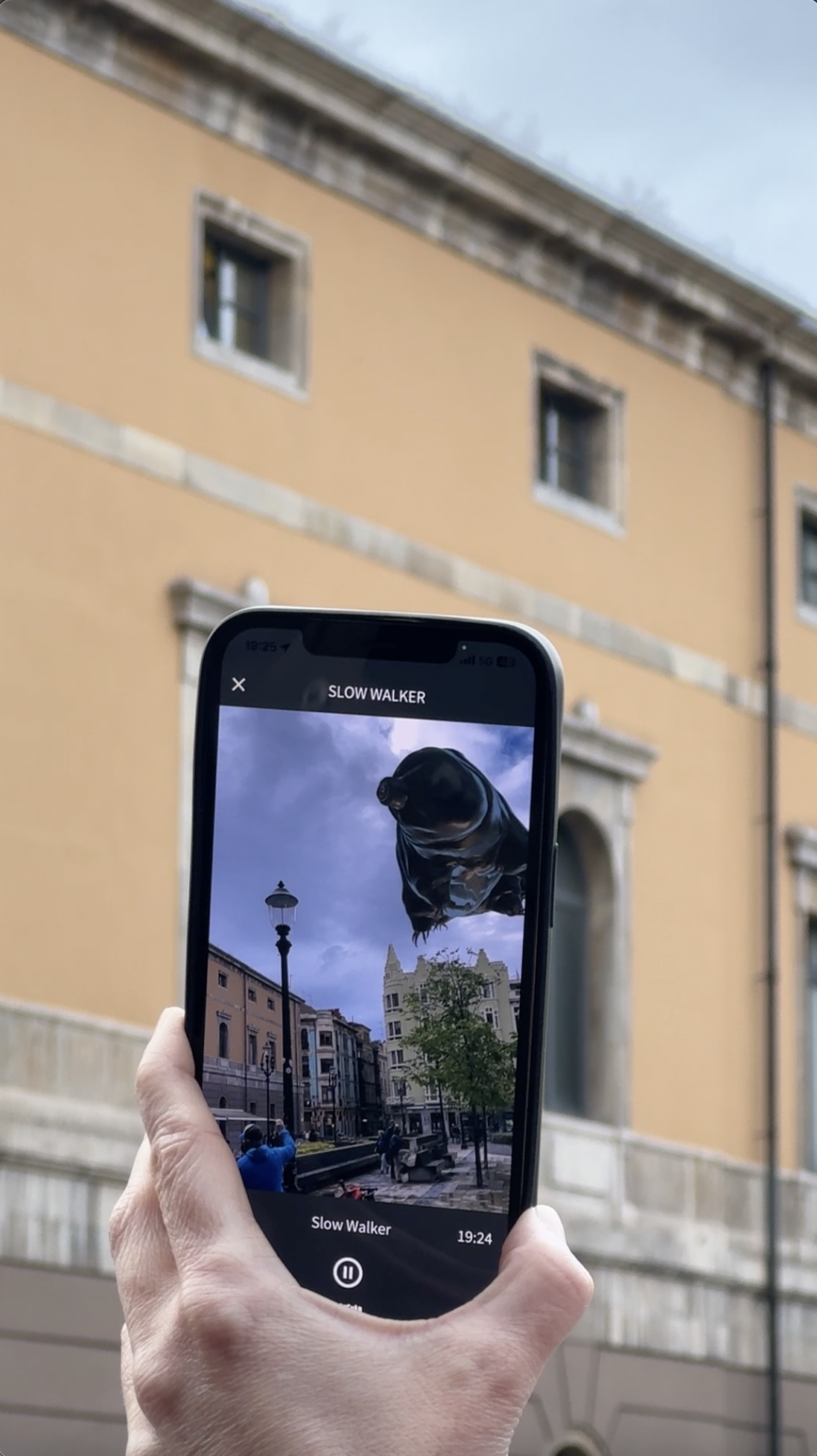Rethinking Narratives: A Conversation with Peder Bjurman
“We’d better start believing in the digital objects and their world as real, because we’re going to be living in it soon enough.”
[OUT OF THE BOX] Peder Bjurman’s “Slow Walker” was one of the “XR” art pieces programmed as part of the L.E.V. Festival 2024 in Gijón, which took place in May. For Realities In Transition, Dark Euphoria asked him about his relationship to XR, his artistic path and favorite tools…

Dark Euphoria | Interviewer: Céline Delatte
First of all, could you give us your personal approach to XR?
Peder Bjurman – Artist, Writer & Director: I like the combination of things and I like to use several layers in all my productions. If it’s a stage production, it’s very rewarding to push forward in new technologies, and I try to do it in every project. For this project, this AR program came up as a solution to a problem, movable full AR experiences. And, knowing that, I developed the piece. I have worked in Quebec a lot, and all of the conceptual artists are called “Idéateur”, a word which doesn’t exist in France. So I like to see myself as the ideator of this project, but of course I’m dependent on a lot of other people; technicians, animators, composers.
C.D. / Interviewer: Indeed, technicians are needed for these kinds of experiences (laughs). As you come from the performance field, what links do you see between performance and XR, I mean the connection with the concept of “space”?
Peder: This is not a walkabout performance but it definitely comes with a narrative: it has a beginning and an end and it works as any theater production. You ask your audience to immerse themselves in the story and to stay there. In this specific experience, I talk directly to the audience but through the “tardigrade”, the animal. It’s my writing, but it’s her talking to the audience. It’s a blind, fat little piglet-like or Buddha-like character. I think of it as a character, and I enjoyed writing for it. Some years ago in New York, I had a cloud as a protagonist. It’s good fun to find unhuman principal actors, to tell their stories and to enthrall the audience. I still see it as a performance, more than an installation.

C.D. / Interviewer: And actually, how did you end up beginning with XR? How did you meet XR for the first time?
Peder: I did a theater production in Stockholm using a very famous Swedish novel, Doctor Glas, and the actor Krister Henriksson from Wallander. I started thinking about how could this performance continue, as it’s been touring the world for the past ten years. And then Corona came and I thought “why not do an audio walk?”. And the XR solution we found for it was the perfect tool. We ended up doing a very popular app that you could walk on your own, when theaters were closed, hearing the voice of the actor. When you turned a corner you would turn a page, so to say. So it’s like you could walk the pages of the novel in real time.
C.D. / Interviewer: Was it involving AR already?
Peder: Yes. At some occasions we used the phone’s haptics, the screen image with AR objects, and geopositioning to track the audience’s speed, to synch all the texts and the spatial soundeffects to the exact positions. The experience was built and distributed through the app Promenad. GPD, navigation, map was built in Unity, and the AR tracking in ArKit and ArCore. A combination of stereo, binaural and spatialized audio was applied throughout the experience, for both the VO, music and all FX. Very challenging timing-wise, but rewarding in the end.

C.D. / Interviewer: What’s your favorite XR tool? I mean, we could guess it’s augmented reality but could you tell us a bit more about it?
Peder: I’m not fidèle to AR but I like the illusion making device of it. I want the illusion to kick in, I want it to be awe-inspiring and enormous. I guess I’d use any new tool for my own purposes to convince the audience of an illusion. But I also tell them that it is an illusion because I believe in revealing your tricks, as you pull them along. This thing we’re showing here is a perfect vehicle. You could almost believe that the tardigrade is there, it’s 30 meters long and appears out of nowhere: it’s like if there’s a crack in time and it suddenly starts talking to you.
C.D. / Interviewer: And what concrete technical tools were needed to build such an experience?
Peder: We’re depending on Google, which is good and bad. They have a fantastic tool, called ARCore. It allows the phone to connect all kinds of different information sources. Your GPS and gyro is involved, the compass as well. The hundreds of pictures taken from the site are processed live by an AI that reads the buildings and detects where your point of view is, and that combination makes it able for us to direct and choreograph the tardigrade around the square. It can then “detect” and talk straight to you. It addresses the audience wherever you are in the square. I love that the digital object, our Tardigrade, can actually be directed like an actor.
C.D. / Interviewer: Definitely sounds like a play! And, where do you globally find your inspirations?
Peder: I read a lot of literature on reality and objects, like OOO (see below) and neuropsychology, to find where and how the fictional and the reality interlace. In this project, I enjoyed playing with the reality and the conceptions of it. It’s been a major issue for me; how we perceive digital objects, and how we learn to adapt to them and to believe in them. I think we’d better start believing in the digital objects and their world as real, because we’re going to be living in it soon enough. I’m not a transhumanist, I’m more conservative but I think we’ll have to take control of the technologies and adapt them to our needs and to humankind and make them serve our own purposes, rather than the big tech companies’. Right now they’re running the world and calling the shots.
(…) So there’s this interesting philosopher, Timothy Morton, who has got a lot of readers in my generation. He has collaborated with a lot of artists like Laurie Anderson and Björk. He’s an eco-philosopher, we could say, with his famous book “Dark Ecology”. But he’s also an avid OOO – object-oriented ontology follower, and he coined the term “Hyperobject” – human made phenomena and objects too large to grasp by the human mind.
With these objects we can’t really understand their extent, or how large they are, like with the internet, global warming, as with a lot of other man-made things. Acid rain for instance, who can really understand or encompass it? Yes, you can touch a raindrop, but you can’t grasp the whole picture.
My Tardigrade project was in part inspired by reading this, and Edmund Burke’s texts on Beauty and The Sublime; ”a delightful horror, a sort of tranquility tinged with terror” as he describes the experience of an artwork or natural phenomena.

C.D. / Interviewer: In my personal vision of the reality, we’re kind of small moving and evolving circles and loops incorporated and imbricated in bigger circles and loops which are themselves in bigger etcetera. So this makes a lot of sense for me… (laughs)
Peder: There’s also Catherine Malabou, a great French writer speaking about neuropsychology and the brain, and how to best adapt to the new conditions.
C.D. / Interviewer: Can you explain a bit more how you collaborate with the companies, and with the technicians that are working on your projects?
Peder: I normally come up with an idea. I give them a challenge: “Can we do this?” Which is rather often quite a tricky challenge, a hard problem. They come up with a kind of solution or a proposal for a solution, and we start developing it. Then they say “We need the script by the 24th” and I start writing. And then I say “I need to look at the animation of the object, to write.” So it’s a give and take, and mutual exchange of proposals, deadlines and collaborations around every detail; movement, soundscape, UX etc. Every movement is animated as a real animation in Blender using Unity. DVA Creative Technologies developed both the app and the animation and I tell them how to make the animal human, endearing or more alive and real. Then we put the pieces together. I bring the music that gives the length of the piece. Then we add the texts and specific spatialized sounds. And for the first time we’ve used AI for the voice overs, in this case ElevenLabs, which was very tricky and time consuming. To soften it we had to pitch it down and had lots of micro pauses edited into it, to make it sound more human. We made her stutter a bit and whisper, which is a very rare find in these VO programs.
C.D. / Interviewer: When I downloaded the app to access “Slow Walker”, I saw that you had different experiences. Is it a personal choice to have all your experiences into one app?
Peder: It’s going to become one separate Slow Walker app where we can only see that project, but for timing reasons, we decided to use the already existing platform that DVA have and where my other pieces are. But I think eventually it’s going to become a separate Slow Walker world, bringing all the versions and languages together.

C.D. / Interviewer: Do you have some small tips to find specific resources about XR?
Peder: There are venues where you can see nice projects and things. Paris has a few venues for digital art and experiences (like Gaîté Lyrique, The Nemo Biennale, Bains Numériques). Montreal has been a hotspot for XR development for some time (SAT, Mutek, Elektra, the Phi Center).
C.D. / Interviewer: Would you have any last advice for an artist or creative who wants to start with XR?
Peder: To not be afraid of not knowing. I’m normally an idiot when I start and then I try to learn the ropes. It’s a very steep learning curve, as I told you. Then you can slowly start to use them yourself cerating small objects and experiences. Now there are so many gadgets and programs you can’t keep track of them.
C.D. / Interviewer: And now to conclude this discussion, where do you think XR is headed and where would you want it headed?
Peder: I think VR is too limited because it’s not a collective experience. We are collective animals, we like to share things together. I have made a lot of pieces, like holographic projections, all collective experiences, and it seems people tend to enjoy being together. In my “Cloud Machine” I connected the audience through sensors, through manual palm readers where they felt like one group. We read them collectively and then reflected their behavior back into the programming of this talking cloud: a feedback loop. And they felt their own presence affecting the structure and behaviour of the piece itself. I think that the future will have to be more collective. Either you see your fellow players, which you can in VR. The company Tin Drum created a digital experience out of Ryuichi Sakamoto’s last concert, where you also see your fellow audience members along with digital objects that float around in space. Very moving since he passed soon after the shooting and recording. I think the future of XR is within these realm, bespoke artistic and deeply personal experiences.





